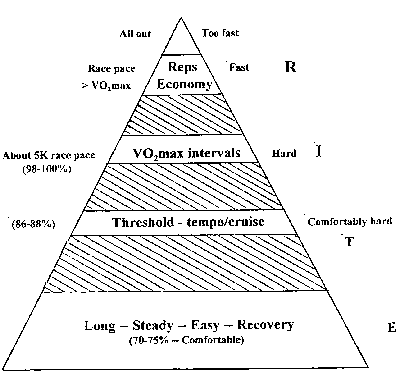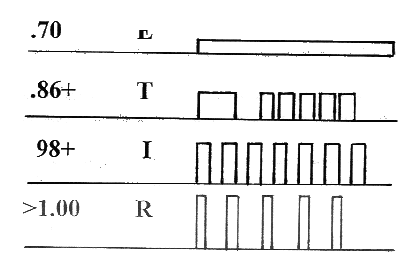|
Running Training: Goals of Training
Article By: Jack Daniels
This article is a continuation from Part 2: Aerobic
Profile
Original Article: Part 1: Principles of Training
Part 3:
Goals of Training.
What a runner is really trying to accomplish through training are the following. (I) Improve the body's ability
to transport blood and oxygen, (2) Increase the ability of the running muscles to effectively utilize their available
oxygen (to convert carbohydrate and fat fuel into useful energy), (3) Increase V02max, which is a sum of #1 and
#2, above, (4) shift lactate threshold to correspond to a faster running speed,(5) improve speed, and (6) lower
the energy demand of running (improve economy). Naturally, there are other goals of training, such as improving
race tactics, elevating self-confidence, changing body composition, bettering self-image, etc., but these less-tangible
factors will all result from improvement in one or more of the above-mentioned factors.
Types of Training. (see Figures 7 and 8 below)
E and L Runs. When you do easy (E) runs to recover from strenuous periods of training or to carry
out a second workout on a particular day, and when you do your long (L) runs, you should run at a pace which
is very close to (E) (easy-run) velocity, which is about 70% of V02max. Long runs (L), improve cell
adaptation, and lead to glycogen depletion and fluid loss (important considerations for distance runners), but
should not be demanding in terms of the intensity (pace) being utilized.
Be advised that the benefits of "E-pace" running are more a function of time spent exercising
than intensity of running, and 70% V02max, which corresponds to 75% vVO2max and 75% of HRmax, is all the harder
you need to go to get the benefits you want at the cellular level and in the heart muscle.
MP Running. The next faster intensity of training
(faster than E pace) is MP (marathon race pace) and is pretty much limited to marathon training. MP is as
it suggests -- the pace at which you plan to race (or run, as the case may be) in your next marathon, and is about
20 to 30 seconds per mile slower than T (threshold) pace, described below. Non-marathoners can ignore this.
T Runs. Threshold pace is about 88% of V02max (90% of VO2max or of HRmax).
Subjectively, T (threshold) pace is "comfortably-hard" running. For many people it is slower than
I OK race pace and for most people it is about 24 see per mile slower than current 5K race pace.
In the caw of T-pace training, it is important to stay as close as possible to the prescribed speed; neither
slower nor faster velocities do as good a job as does the proper speed. Here is a case where going too fast --
which many runners automatically try to do -- is simply not as good as running at the right pace. T-pace
training improves your lactate threshold.
I Pace. The next important training velocity is the one that stresses and improves
V02max V02max-interval (I) velocity. The intensity here should be equal to vVO2max- I believe most people should
shoot for 98% - 100% of HRmax, rather than always demanding a 100% value, if using heart-rate as a guide. This
is suggested because if maximum heart rate coincides with a pace of 6:00 per mile, for example, then certainly
5:50 or any pace faster than 6-minute pace will also elicit maximum heart rate, but is too fast for the purpose
of the training session -- optimum result with the least possible stress. No single run, which makes up a series
of Intervals, should exceed 5-minutes.
Interval (I) training is demanding, but by no means is it all-out running. In the case of I pace,
the harm of going too fast is that no better results are obtained and the excessive pace will probably leave you
over stressed for the next quality-training session.
R Pace. Repetition (R) velocity is faster than I pace, at the very least,
but, unlike I and T, is not based on V02max. Rather, R pace is to a great extent, based the
race for which you are training; it is more designed for good mechanics at a pretty firm pace. A runner, in training
for a I OK, with a vVO2max of 300 meters per minutes will have the same threshold velocity and V02max (I)
velocity as any other runner whose vVO2max is also 300, but who may be training for a 1500-meter race. This is
because T and I paces are related to the same vVO2max value, and any runners with a 300 vVO2max would
have identical training speeds for I and T training. On the other hand, R pace would differ
for the two runners cited above, because one is running for a faster race than is the other, and needs good economy
and speed for that faster pace. Keep in mind that the purpose of Rep-pace training is to improve economy and speed;
it is not to benefit V02max or lactate threshold. It is important to always have set in your mind what every workout
is designed to do for you, even if that benefit is pure relaxation.
No-man's Land. In Figure 7, you will see that there are 3 shaded areas,
between R and I, between I and T and between T and E. Except for MP
(between T & E) these are "No man's land of training. Training intensities that fall into
'No man's land," are either too easy or too hard to reap the benefits you want. You are not, as may sometimes
be assumed, achieving the purpose of training the two systems on either side of the chosen intensity. What you
are doing might be termed, "Quality-junk" training. At the least, it is training aimed at accomplishing
an unidentifiable purpose. Always have a purpose for every training session; ask yourself the following questions:
"What system do I hope to improve by doing this workout,' and 'What am I really trying to accomplish?"
Support Systems. There are a few aspects of training that I call 'Support systems,"
and I believe that each individual has special needs in this area of training. Support-system training is designed
to produce fewer direct benefits, but may mean the difference between success and failure.
Some things to work on in support-system training include flexibility, muscle strengthening, mental/psychological
approaches to performance enhancement, and so on. Different individuals benefit to varying degrees from these different
types of support-system . . . As with all types of training, be sure that what you are doing helps satisfy the
needs that you have and doesn't just add unproductive activity to your overall training program. Often, trial and
error is the only way to see if something works for you, and always remember to give a new approach to training
a fair trial not just a few days.
Certainly, some strengthening exercises help prevent injury, as can flexibility training, massage, etc., but there
is a reasonable limit to every type of support system Always keep foremost in your mind what your goals are. For
example, are stretching exercises used to improve your running, or just to become more flexible?
The same thing can be said for the various types of training -- are you doing a particular type of training because
you like it and are good at it, or because it will produce the results you want in races? It all depends on your
goals and expectations; be clear and realistic with these and you will almost always be happy with your performance.
Figure 7

Training Intensities
Figure 8
Types of Training
FVDOT TYPE

- E -- up to 2-½ hours steady
- T -- 20 min steady or up to 10% cruise intervals
- I -- up to 5 min per workout & up lesser of 8% or 6 miles total
- R -- up to 2 min per workout & up lesser of 5% or 4 miles total
Part 4: Determining your current level of Fitness: Continue
Here
International Copyright © of CoachesEducation.com. All Rights Reserved.
Reproduction in whole or in part in any form or medium without
express written permission
of CoachesEducation.com is strictly prohibited.
|
|
![]()




